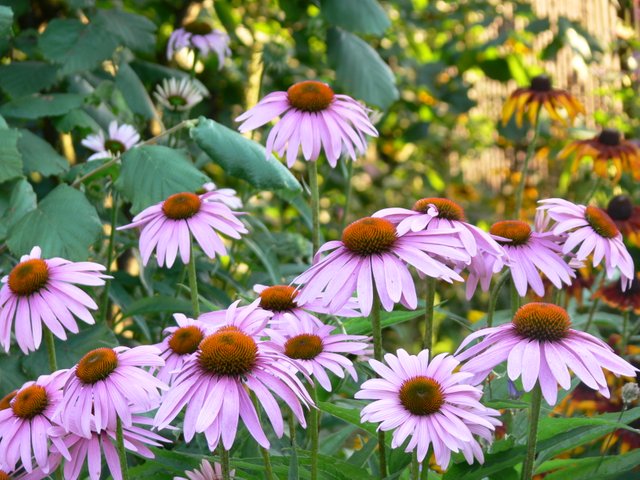
Healing with medicinal plants is a way of life. It's getting to know your daily allies and your own limits in managing your health. In this perspective, do not wait to be very sick to heal but choose the plant or plants that help restore imbalances as soon as they are felt.
there is no drug that prevents the disease or improves the functioning of our body. This is the strength of medicinal plants, in their capacity to increase, among others, resistance to stress, fatigue, and even cold, among these plants I present you an extraordinary plant that is a natural fortifier and also stimulates the defenses and strengthens the body it is called "Echinacea".
 History of echinacea
History of echinacea
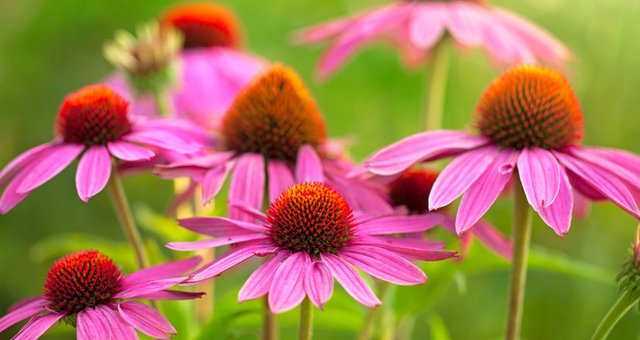
It is native to the plains of North America.The tribes of Amerindians living in the cold plains of North America have most likely used Echinacea for centuries before settlers arrived.
Echinacea angustifolia was the species most used by the various tribes (Cheyenne, Comanche, Crow, Dakota, etc.), for the following indications:
 Buring snakes and poisonous spiders (internally and externally)
Buring snakes and poisonous spiders (internally and externally)
 Froids, sore throat, cough (root chewed)
Froids, sore throat, cough (root chewed)
 Tooth root (herbal tea or root juice)
Tooth root (herbal tea or root juice)
 Inflammation of the gums or mouth (herbal tea or root decoction)
Inflammation of the gums or mouth (herbal tea or root decoction)
 Onillons (externally applied)
Onillons (externally applied)
 And more.
And more.
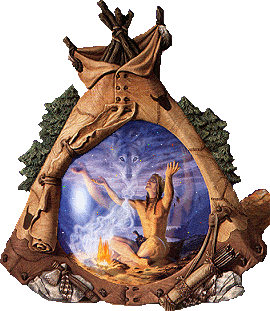
The root of the plant was already used by
![]() The Amerindians, externally during wounds, burns, insect bites.
The Amerindians, externally during wounds, burns, insect bites.
![]() The Comanches chewed her for toothache and throat.
The Comanches chewed her for toothache and throat.
![]() The Sioux used it very often as an antidote for snake bites and during infectious .
The Sioux used it very often as an antidote for snake bites and during infectious .
It was registered between 1916 and 1950 on the list of pharmaceutical ingredients in the US National Formulary, before being forgotten for the benefit of antibiotics. It was German doctors who rediscovered it around 1920, and it is thanks to one of them, Gerhard Madaus, that it is cultivated in Europe. Echinacea is regaining interest especially in the United States, since the discovery of bacterial resistance to antibiotics.
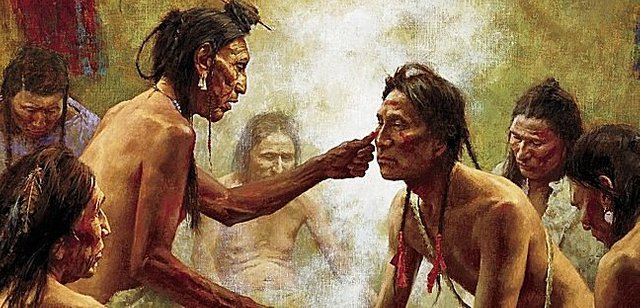
H.C.F. Meyer was the first doctor to use the plant in the United States in the mid-1800s, Native Americans taught him how to use it. He then passed on his knowledge to the famous professor John King and the equally famous pharmacist John Uri Lloyd, who then spread this knowledge.
Dr. Ellingwood describes in 1919 an experiment that Meyer undertook on himself :
With the courage of his convictions, he injected the venom of a rattlesnake into the index finger of his left hand. The swelling was swift and went up to the elbow within six hours. He then took a dose of the remedy, bathed the organ with great care, and went to bed. At sunrise after four hours, the pain and swelling had disappeared. "
Homeopaths introduced it into their medical field in the early 1900s (first appearance - Clarke 1902). In 1930, large quantities of roots were exported to Europe. The French bought almost all US crops in 1937. The Germans (thanks to Dr. Gerhard Madaus and his firm) then drove off local plantations. Detailed studies of the plant in Europe followed.
In recent years, echinacea has been the subject of controversy and the new studies do not go in the direction of the old ones. The latest studies do not seem to prove very effective, while some in 2007 concluded that the risk of colds was reduced by almost 60%.
Who to believe? it's the whole question, but based on the principle that, if you do not do good, it can not hurt, and that natural ancestral medicines were rarely wrong, it may be worth trying.
 Echinacea: How to recognize it?
Echinacea: How to recognize it?
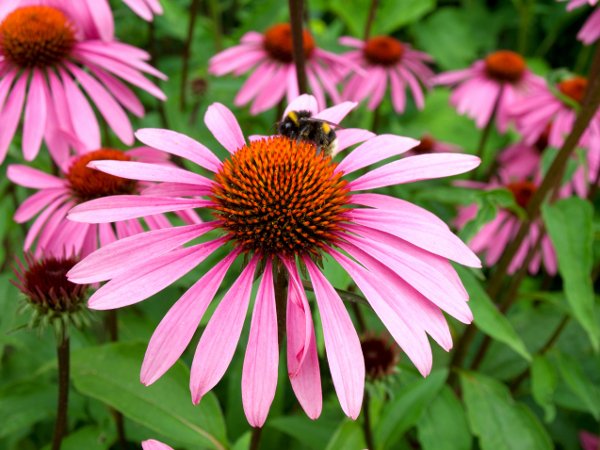
Echinacea is an herbaceous plant recognizable by its large purple, purple, pink or white flowers, which may exceed 1 meter in height. These flowers surround a bulging heart, covered with rigid flowers and a little spicy, which earned him the name of "little hedgehog". Echinacea belongs to the same family as Dandelion (Asteraceae).
It is a robust ornamental plant of which there are ten species. Its leaves are lanceolate. The inflorescence is a large flower head with peripheral flowers ranging from purple to purple.
 Latin name:
Latin name:
Echinacea angustifolia, E. purpurea, E. pallida
 Common name (s):
Common name (s):
purple rudbeckie
 Family:
Family:
Asteraceae
 Harvest period:
Harvest period:
The flowers are harvested at the beginning of flowering in June, the roots in autumn, and only those of plants aged 3, 4, or 5 years.
 Active subtances
Active subtances
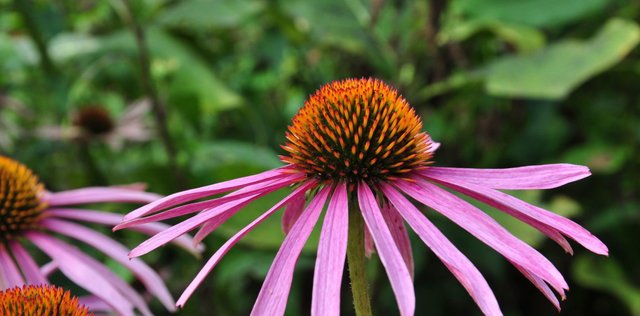
Echinacea is a very complex medicinal plant that contains several families of active molecules. It contains specific polysaccharides (immunostimulants), glycoproteins (immunostimulants), a volatile oil, derivatives of caffeic acid and cichoric acid known as echinacosides (antioxidants), the famous alkylamides (antivirals) and polyacetylenes.
There is controversy over the roles and prevalence of these active ingredients. According to some, the most powerful are the alkamides (or alkylamides). According to others, it is the polysaccharides. That said, the synergy of the active principles of echinacea remains more effective than the combination of the effects of its isolated molecules.
This is what Jürg Gertsch of the University of Bern calls "intelligent mixtures". In fact, according to Dr. Rudolf Bauer, professor at the Institute of Pharmacognosy at the University of Graz (Austria) and world expert in echinacea extract, a good echinacea extract should contain alkamides, cichoric acid, polysaccharides and echinacosides.The overall effect of a medicinal plant can usually be explained by a single principle. active. This is called a polymolecular therapy.
By simplifying to the extreme, echinacea contains two types of active components:
The isobutylamides, soluble in alcohol, which cause the bubbling sensation on the tongue and the sialagogue effect (salivation). It can be said that the duration of salivation + the tingling force = indicator of the amount of butylamides in the plant.
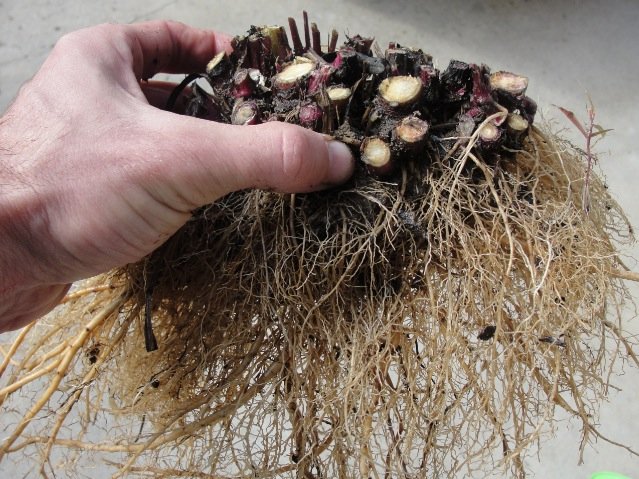
Mucopolysaccharides, complex sugars soluble in water.
We now know that both types of components are responsible for the immuno-stimulatory effects.
This explains why the alcoholic extract is as effective as the decoction or the cold infusion. The alcoholic extract will contain almost only butylamides, the decoction will contain almost only polysaccharides.
Mucopolysaccharides are not digested, so they do not enter the general circulation. How do they manage to exert their effects? One of the most plausible theories is through the gastrointestinal immune system.
80% of our immune system is located around the gastrointestinal area to protect this major port of entry. The polysaccharides could, by coming into contact with the Peyer's patches (where the lymphocytes protecting the intestine are located), stimulate the immunity in a general way.
Dyeing is very effective, especially that prepared from fresh roots. As a second choice, use dry root tincture. The decoction of the dry root is less active.
 Fresh or dried plant?
Fresh or dried plant?
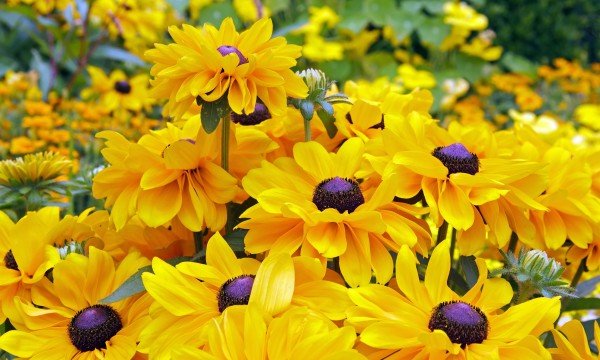
Researchers have compared echinacea extracts made from fresh and dried plants. They found that when the extract is made from fresh plants, the concentration of all the active ingredients is higher. For example, alkylamides are 2 ½ times more concentrated in fresh Echinacea extract (79.9 mg / 100g) than in dried echinacea extract (30 mg / 100g).
 Echinacea: Used parts
Echinacea: Used parts
Herbal medicine uses different plant parts depending on the species:
![]() The underground parts of Echinacea angustifolia (narrow-leaved Echinacea).
The underground parts of Echinacea angustifolia (narrow-leaved Echinacea).
![]() Flowery aerial parts and underground parts of Echinacea purpurea (purple echinacea)
Flowery aerial parts and underground parts of Echinacea purpurea (purple echinacea)
![]() Underground parts of light Echinacea (Echinacea pallida).
Underground parts of light Echinacea (Echinacea pallida).
 Therapeutic properties
Therapeutic properties
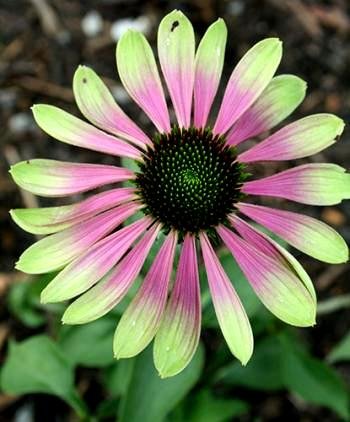
Echinacea has various therapeutic effects that are useful for preventing and treating colds and flus. Studies on the extract have shown that echinacea is:
 Anti-inflammatory
Anti-inflammatory
 Immunomodulatory
Immunomodulatory
 Antiviral
Antiviral
 Antibacterial
Antibacterial
According to recent scientific studies, echinacea has the following beneficial effects :
![]() Neutralization of viruses involved in respiratory infections;
Neutralization of viruses involved in respiratory infections;
![]() Neutralization of bacteria involved in respiratory infections;
Neutralization of bacteria involved in respiratory infections;
![]() Neutralization of various parasites and pathogens (such as trypanosomes);
Neutralization of various parasites and pathogens (such as trypanosomes);
![]() The reduction of inflammation in the cells of the epithelium (especially for the respiratory tissues, which could help for cases of hyper-stimulation of the inflammatory response during the strong influenza and counter the effect of the "cytokine storm ");
The reduction of inflammation in the cells of the epithelium (especially for the respiratory tissues, which could help for cases of hyper-stimulation of the inflammatory response during the strong influenza and counter the effect of the "cytokine storm ");
![]() Stimulation of immunity:
Stimulation of immunity:
 The increase in the number of circulating white blood cells;
The increase in the number of circulating white blood cells;
 Their ability to phagocyte, that is, to devour intruders;
Their ability to phagocyte, that is, to devour intruders;
![]() Decreased secretions of mucus during colds.
Decreased secretions of mucus during colds.
The National Agency for the Safety of Medicinal Products (ANSM) places Echinacea in its list of medicinal plants traditionally used.
The World Health Organization (WHO) and the European Medicines Agency (EMA) consider as "well established" the use of Echinacea root in "the prevention and treatment of colds and blows of cold "5 without exceeding two weeks of treatment. In addition, the EMA advises the consultation of a doctor or a health professional.
 Echinacea Immune-stimulating properties
Echinacea Immune-stimulating properties
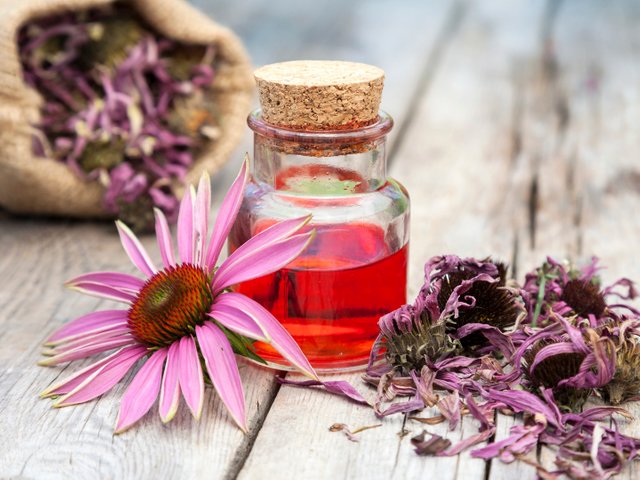
The combined presence of alkylamides (lipophilic fraction), polysaccharides and caffeic acid derivatives appears to be a major factor of immunostimulant activity, these components stimulate the immune system in different ways. They have an action against viruses, bacteria and fungi. Prevent microbial germs from attacking connective tissue and limit their progression by:
 Stimulation of macrophage activity (arabinogalactan), increased phagocytosis of granulocytes and macrophages (alcoholic extracts of the root),
Stimulation of macrophage activity (arabinogalactan), increased phagocytosis of granulocytes and macrophages (alcoholic extracts of the root),
 Increase in the number of white blood cells and in particular lymphocytes.
Increase in the number of white blood cells and in particular lymphocytes.
 Increased resistance to effort (echinacea is said to be adrenal-mimetic).
Increased resistance to effort (echinacea is said to be adrenal-mimetic).
 Use of echinacea during winter
Use of echinacea during winter
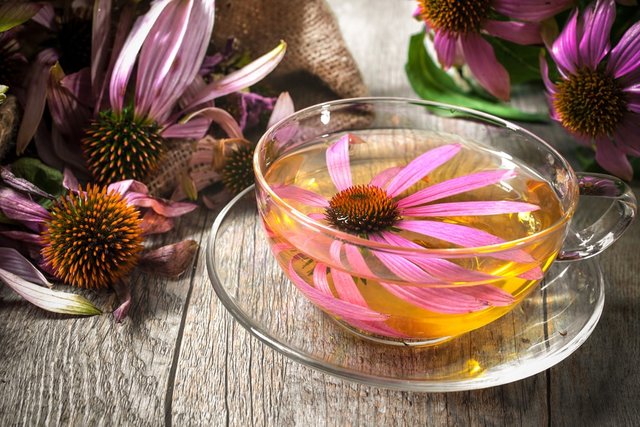
 Prevention
Prevention
Prevention is not the place where Echinacea shines brightly. For prevention, the Astragalus of China is more effective. But for lack of astragalus, echinacea will do the trick.
Echinacea should be taken in early winter or when people in your home or workplace begin to develop various respiratory infections, especially if you think your immune system is weakened by an imbalance of the 4 pillars: sleep , stress, sport and diet .
It is particularly useful if you are often tired or exhausted, due to chronic stress, too much work, personal or family worries, or a combination of all these factors. You may take longer to heal than normal, whether for a cold or a small open wound. You may tend to abscess or boil on a regular basis.
You caught colds repeatedly last winter, and some problems became chronic (eg sinusitis).
Take 1 teaspoon morning and evening for 2 to 3 weeks. This will lift your defenses, with more white blood cells circulating, and more active white blood cells.
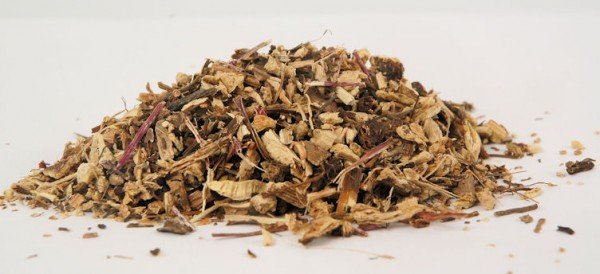
 Infection
Infection
Few people know how to use echinacea properly. First you have to find a quality plant extract. Then:
![]() Start the catches as soon as the first symptoms appear;
Start the catches as soon as the first symptoms appear;
![]() Take a high dose, 1 teaspoon every 2 hours for the first 3 days;
Take a high dose, 1 teaspoon every 2 hours for the first 3 days;
![]() Then change to 4 teaspoons a day as long as the symptoms persist.
Then change to 4 teaspoons a day as long as the symptoms persist.
In decoction: boil 1 g of roots (for a cup of water) for 10 min. Drink up to 3 cups a day. I particularly like it, added to an infusion of thyme sweetened with honey. In case of pharyngitis or flu, I prepare a thermos for the day. This remedy combines perfectly with other treatments, both homeopathic and allopathic.
Some studies, as well as clinical experience, show that the duration of serious infections can be shortened by 24 hours thanks to echinacea, which is far from negligible.
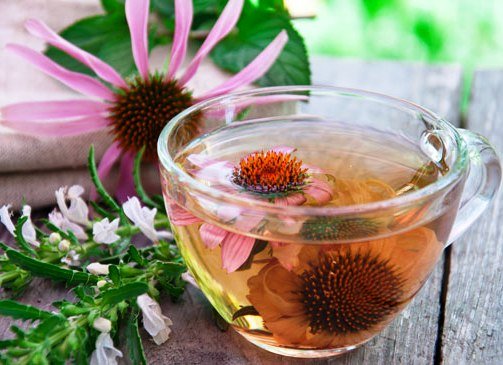
 Duration of treatment
Duration of treatment
The following recommendation is often made: stop echinacea after one week, otherwise the effects on the immune system will peak.
This claim has been relatively recently denied by Kerry Bone, Australian herbalist and author, and American herbalist and author Paul Bergner. It was based on a single study by Jurcic & al. published in 1989 with a graph that would have been misinterpreted.
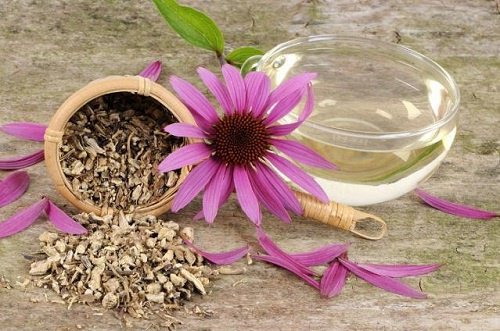
The graph shows that the stimulating effect on phagocytosis declines after 5 days and reaches a plateau after 8 days. On the other hand, what was often omitted in the translations and discussions is the fact that the dose of echinacea was stopped on day 5. So echinacea continued to act 3 days after stopping the catches.
If you keep taking it for more than a week, and if the immune system needs it (again, this is a key indication), there is no reason to think that the stimulating effect will cap. Clinical experience confirms this fact, the benefits of echinacea continue well after one week of intake. Eclectic doctors sometimes used it for months.
 Against Indications
Against Indications
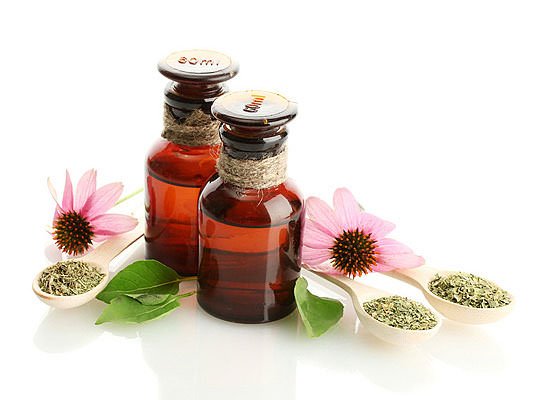
Allergy to Echinacea or Asteraceae is the only confirmed contraindication. On the other hand, since echinacea is immunomodulatory, there is some doubt as to its safety in immunosuppressed patients. To avoid.
Some authors claim that Echinacea is contraindicated in patients with autoimmune diseases. The mechanisms of action of echinacea do not support such a warning, but professional judgment is required.
Echinacea is well tolerated, but the advice of a phytotherapist is essential before taking any medicine. First, because the plant does not dispense antibiotics and other anti-infective agents. Second, because his self administration can make you miss a serious infection. It is not recommended under 6 years and in pregnant or breastfeeding women without medical advice.
source: https://www.medicalnewstoday.com/articles/252684.php
https://www.ncbi.nlm.nih.gov/pubmed/20036523
Thank you for stopping by, I hope you enjoyed. Please share your thoughts below and comment on what you think :]
Best regards,



Interesting read on a common natural remedy.
Downvoting a post can decrease pending rewards and make it less visible. Common reasons:
Submit
thanks,welcome to steemit ^^
Downvoting a post can decrease pending rewards and make it less visible. Common reasons:
Submit
Happy Birthday and Happy New Year
Downvoting a post can decrease pending rewards and make it less visible. Common reasons:
Submit
absolutely fantastic!!!!!!!!!!!!
Downvoting a post can decrease pending rewards and make it less visible. Common reasons:
Submit
thank you so much dear; thanks for stop by my post. glad to see you again.happy christmes dear @allthereisislove,thanks for your support.
Downvoting a post can decrease pending rewards and make it less visible. Common reasons:
Submit
more than welcome-thank You !!!!!!!!!!!
Downvoting a post can decrease pending rewards and make it less visible. Common reasons:
Submit
@originalworks
Downvoting a post can decrease pending rewards and make it less visible. Common reasons:
Submit
The @OriginalWorks bot has determined this post by @aek081969 to be original material and upvoted it!
To call @OriginalWorks, simply reply to any post with @originalworks or !originalworks in your message!
Downvoting a post can decrease pending rewards and make it less visible. Common reasons:
Submit
معلومات قيمة دائما
حصلت على تصويت من
@arabsteem curation trail !
و تم اختيار مقالتك ضمن مقالات يومية مختارة للنشر اليوم في مقالنا! :)
Downvoting a post can decrease pending rewards and make it less visible. Common reasons:
Submit
well done.. I like the content you share dear brother.
Downvoting a post can decrease pending rewards and make it less visible. Common reasons:
Submit
Love this plant, it has so many benefits! thx for sharing @aek081969!
Downvoting a post can decrease pending rewards and make it less visible. Common reasons:
Submit
You got a 1.72% upvote from @postpromoter courtesy of @aek081969!
Downvoting a post can decrease pending rewards and make it less visible. Common reasons:
Submit
3.55% @pushup from @aek081969
Downvoting a post can decrease pending rewards and make it less visible. Common reasons:
Submit